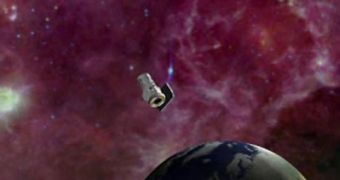The recently launched WISE telescope began its survey mission yesterday, once experts concluded that all of its systems were up and operational according to specifications. The new instrument reached orbit on December 14, and mission controllers have been dealing with testing and calibrating it ever since. Its lens cover was jettisoned during a flawless procedure a couple of weeks ago, and now the four detectors aboard the NASA telescope are ready to start observing the Universe in infrared wavelengths, experts at the Jet Propulsion Laboratory (JPL), in Pasadena, California, say.
It is estimated that the observatory has the ability to detect signals coming from galaxies and other cosmic structures located as far as ten billion light-years away. During the nine months the spacecraft is scheduled to cover, it will create a full map of the Universe, and will then have sufficient time to make another one. The second one will cover, however, just half of the visible Cosmos, mission managers say. The four detectors aboard the spacecraft are extremely apt at detecting even the faintest signals from a variety of sources, as they function at 3.3, 4.7, 12, and 23 microns, respectively. The survey that WISE will complete is expected to be about 1,000 times more sensitive than any other before it.
The new, wide-angle, orbit-based telescope will be able to detect even the dimmest traces of light or infrared-wavelength radiation coming in from the spaces between stars and galaxies. For a while, astronomers believed that these recesses of the skies were empty, but recent discoveries in the field taught them better than that. Vast dust clouds, brown dwarf stars, and large asteroids could all be lurking in these spaces. Experts say that large-scale asteroids heading for our planet could exist there as well, and thus the need for instruments to investigate these cosmic “dark spots” arises.
In order to be able to detect very cold objects lurking in the Universe, WISE will have to be cooled to a lower temperature than that they have. As such, plans are for it to operate at about minus 258 degrees Celsius, or minus 433 degrees Fahrenheit, only 15 degrees above absolute zero (0 Kelvin). Solid hydrogen was chosen as the main cooling material, over liquid nitrogen, which is generally used for this kind of missions. According to experts who are intimately familiar with the mission, the observatory is able to snap about 11 pictures per second, for a total of 1.5 million photos in ten months of operations.
JPL manages WISE for NASA's Science Mission Directorate, in Washington DC. The principal investigator, Edward Wright, is based at the University of California in Los Angeles (UCLA). The mission was competitively selected under NASA's Explorers Program, which is managed by the Goddard Space Flight Center, in Greenbelt, Maryland.

 14 DAY TRIAL //
14 DAY TRIAL //